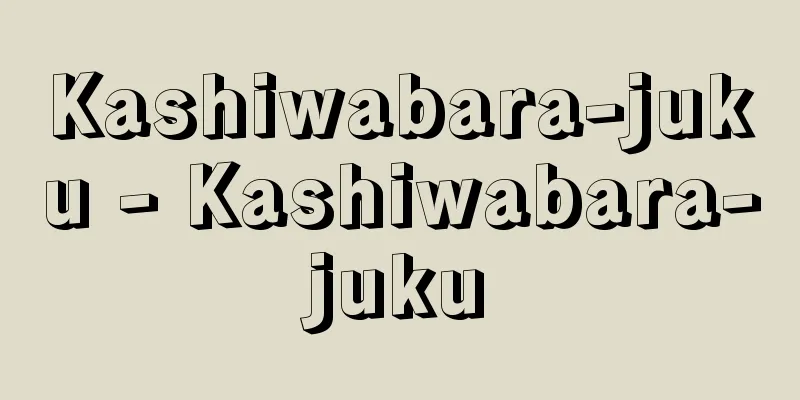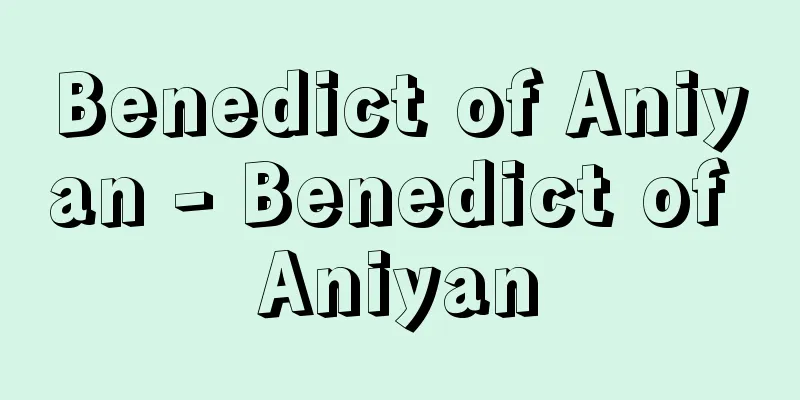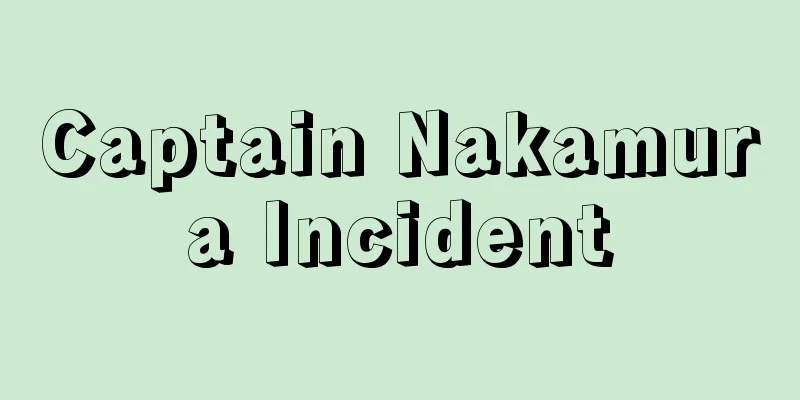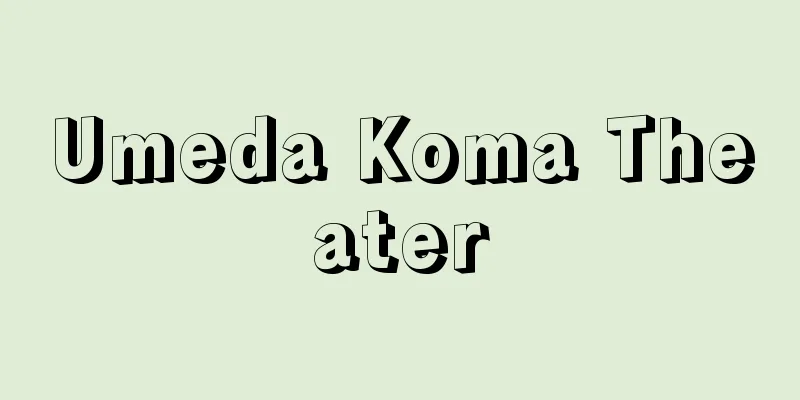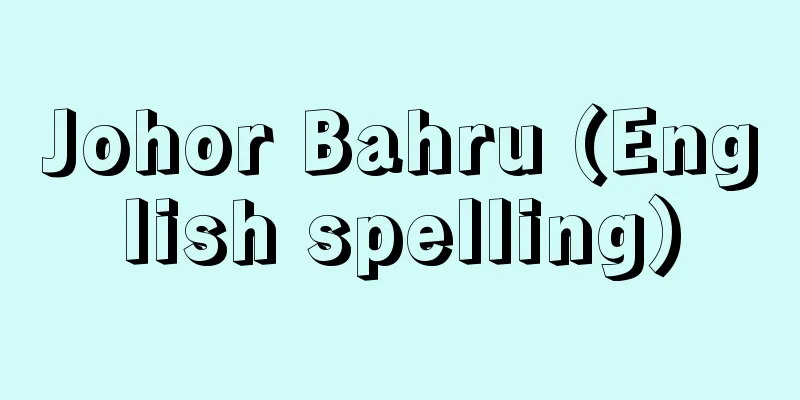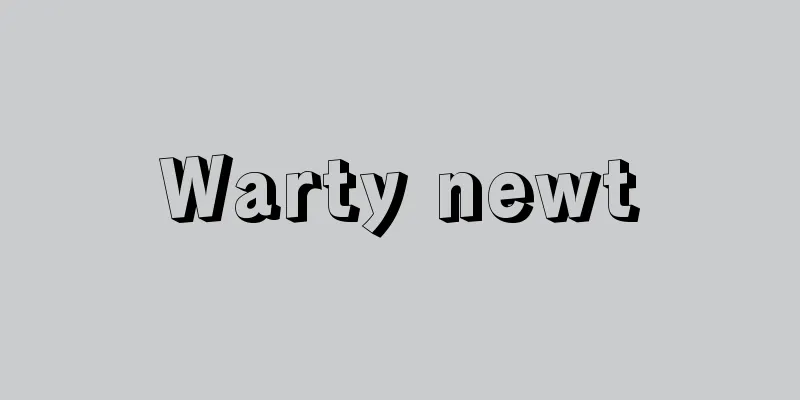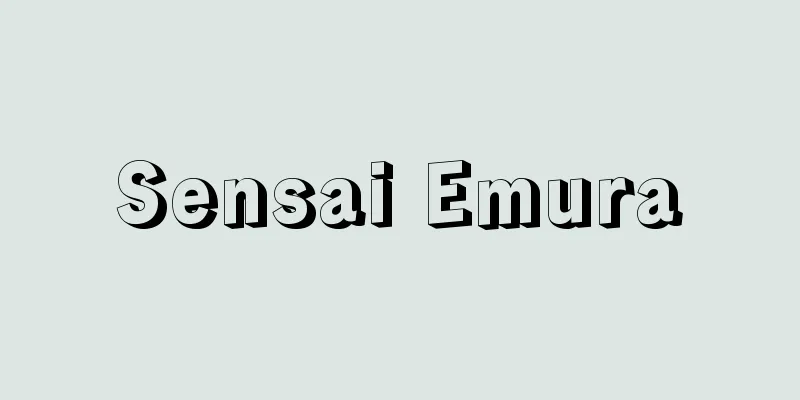Textbook - Kyokasho
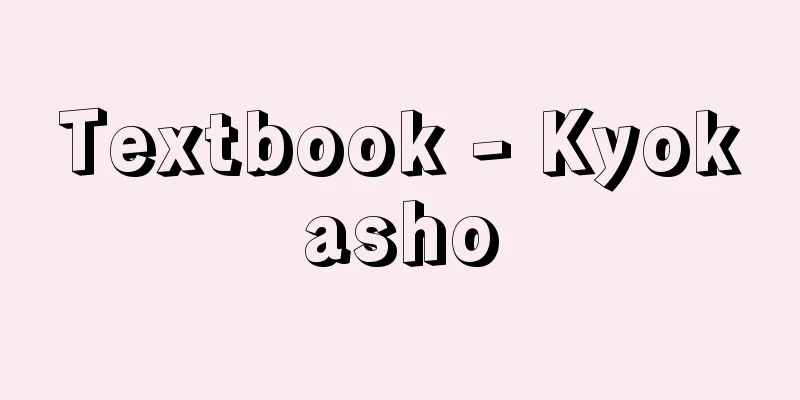
|
Generally speaking, it refers to books that are educational materials edited into an appropriate format for teaching and learning activities, i.e., textbooks used in schools. According to the "Temporary Measures Law Concerning the Publication of Textbooks," it is defined as "books for children or students used for teaching purposes as the main teaching materials for subjects organized and arranged in accordance with the curriculum of elementary schools, junior high schools, high schools, and equivalent schools, which have been approved by the Minister of Education, Culture, Sports, Science and Technology or which are copyrighted by the Ministry of Education, Culture, Sports, Science and Technology" (Article 2, Paragraph 1). [Mitsuhiko Asakura and Shuichi Miyazaki] historyThe origins of textbooks in Japan can be traced back to ancient times. The first textbooks are said to be classics such as Buddhist and Confucian scriptures and sutras, Japanese literature and waka poetry, and historical works, but the most well-known are the oraimono, which were widely used from the Middle Ages to the early modern period. Oraimono were originally models for letter writing, but their content subsequently changed with changes in society, and they were divided into didactic, industrial, and geographical texts, and were used primarily in terakoya schools. A representative example of this is the Teikininourai. Japan's modern school education system began with the promulgation of the "School System" in 1872 (Meiji 5), and the textbook system during this "School System" period was one in which textbooks were freely published and freely selected. For this reason, there was a wide variety of textbooks during this period. Along with the traditional textbooks mentioned above, translations of Western textbooks and educational books introducing Western culture and science were widely used as textbooks. In addition to these textbooks, wall charts were treated as being of the same rank as textbooks and were the main teaching material for introductory elementary school students. During the "Gakusei" period, the Ministry of Education and normal schools also edited and published textbooks, but they did not suppress or control private textbooks. However, in 1880, the Ministry of Education established a textbook investigation office within the Regional Education Bureau to investigate the suitability of textbooks in each prefecture and issue a list of textbooks, including those that were banned. The background to this movement is closely related to the Meiji government's suppression of the Freedom and People's Rights Movement at the time and its educational policies that strongly promoted Confucian moral education as a measure to indoctrinate the people. The following year, in 1881, a system of submission was introduced that required each prefecture to report the textbooks used in elementary schools to the Ministry of Education each time. Then, in 1883, the system of submission was changed to an approval system, and not only elementary school textbooks but also textbooks for public junior high schools and normal schools became approval systems, and the control of textbooks tended to become stronger. In 1886, the certification system was started based on the "Elementary School Act" and "Middle School Act" enacted by Mori Arinori, the first Minister of Education. The "Textbook Certification Ordinance" was then enacted, and the textbook certification system for elementary schools, middle schools, and normal schools was established. However, this certification ordinance was abolished soon after it came into force, and in 1887 the "Textbook Certification Regulations" were enacted. These certification regulations became the basic regulations for textbook certification thereafter. Textbooks for elementary schools were selected by a prefecture-level elementary school book review committee, which would review them and then the governor would make the decision on their adoption based on the committee's report. Rules for the review were established and amendments were made to prevent impropriety in the review and selection of textbooks, but improprieties in textbook selection did not disappear. Then, in 1902, a large-scale bribery scandal occurred in relation to textbook selection. This is known as the Textbook Scandal. This case affected one prefecture, three metropolitan areas, and 35 prefectures, and around 200 people were arrested, including governors, school inspectors, principals, teachers, and people involved with textbook companies. As a result, the major textbooks of the time were penalized and could not be adopted, leaving a textbook vacuum. This incident was the decisive turning point for the introduction of the national textbook system. The national system was established by the "Revision of the Elementary School Act" in 1903, and came into effect the following year in 1904. The national textbooks were subsequently revised several times, and in 1941 (Showa 16), when elementary schools were reorganized into national schools, new textbooks with a wartime theme were compiled for each subject. The certification system for textbooks for the old middle schools had been largely maintained, but this also shifted to a national system with the "Revision of the Middle School Act" in 1943. After the Second World War, the Supreme Commander for the Allied Powers (GHQ) issued a directive in October 1945 entitled "Administrative Policies for the Japanese Education System" which prohibited the spread of militarism and extreme nationalistic ideas, particularly in primary education. In December of the same year, directives on State Shinto and Shrine Shinto, as well as directives on the suspension of ethics, Japanese history and geography, led to the deletion of all matters relating to Shinto doctrine from all textbooks and teacher's guides in use, and the suspension of classes in ethics, Japanese history and geography in all schools. Furthermore, textbooks and teacher's guides for these subjects were recalled, and plans were ordered for the compilation of new textbooks and teacher's guides to replace them. In addition, instructions were given to delete any sections related to the war from other textbooks as well, and students were instructed to cover them up with ink, resulting in the use of so-called "blacked-out textbooks." In 1947, the "School Education Law" was promulgated along with the "Fundamental Law of Education," and a new 6-3 school system was established. With this, the national system was abolished, and a certification system was established in which textbook editing was carried out by private companies. In the same year, the Ministry of Education (now the Ministry of Education, Culture, Sports, Science and Technology) issued "Course of Study (Draft)" for each subject, and it was expected that each school would independently create its own curriculum using these as a reference. Although the aim was to realize the democratization of education, the certification system was not implemented immediately from 1947, and the Ministry of Education proceeded with editing textbooks based on the course of study until the system was established. After that, in 1948, the "Textbook Certification Regulations" and the "Temporary Measures Law for the Publication of Textbooks" were promulgated, and the "Textbook Certification Standards" were established the following year in 1949. The Textbook Certification Regulations stipulate that the standards for certification must be "in accordance with the spirit of the Fundamental Law of Education and the School Education Law, and suitable for use as a textbook," that certification must be carried out by the Minister of Education (now the Minister of Education, Culture, Sports, Science and Technology) based on the report of the Textbook Certification Committee (later renamed the Textbook Certification Research Council), that the certification process must be completed in three stages: manuscript review, proofread review, and sample copy review, and stipulate other matters regarding application procedures and revisions. In addition, the Temporary Measures Act on the Publication of Textbooks stipulates the significance of textbooks, publication of textbooks, textbook exhibitions, adjustment of supply and demand for textbooks, and list prices. As the certification system was established in this way, the publication of textbooks written by the Ministry of Education was halted, and from 1949 new certified textbooks were used and rapidly spread. [Mitsuhiko Asakura and Shuichi Miyazaki] Changes in the textbook system after World War IIThe textbook system was established based on the certification system implemented as part of the education reform after the Second World War, and continues to exist to this day, but during this time many problems have arisen with the certified textbooks. In particular, social studies textbooks became a political issue. In 1955, the Democratic Party of Japan (as it was then called) published "The Delightful Textbook Problem," which criticized the content of social studies textbooks as "biased education," and it became a political issue. In this situation, in 1956, the Ministry of Education submitted a textbook bill to the Diet with the aim of strengthening the certification system. This bill was withdrawn without being debated, but efforts were subsequently made to improve and strengthen the system by increasing the number of certification investigators and appointing full-time textbook inspectors, and the certification system essentially became stricter. In particular, the Ministry of Education's certification inspectors were increasingly making stronger suggestions for revisions to manuscripts submitted for certification, making it more difficult to pass the certification process. In 1958, the Enforcement Regulations of the School Education Law were revised, clarifying the legal binding power of the Course of Study. The new Course of Study for elementary and junior high schools announced the following year, 1959, was no longer a "trial draft" but was positioned as the standard for the educational curriculum. The contents of authorized textbooks were to be edited based on the Course of Study, so the goals and contents of the Course of Study were directly reflected in authorized textbooks. From the 1961 academic year when the new Course of Study was implemented, the timing of authorization, which had been left to the discretion of textbook publishers, was regulated, and the year of publication of textbooks that were to be accepted for authorization after 1961 was set as 1965 for elementary school textbooks. Due to this regulation, publishers of elementary school textbooks could not revise or publish new textbooks until 1965. Furthermore, publishers were in principle limited to one type of textbook, and the variety of textbooks was greatly reduced. The free provision of textbooks to elementary and junior high schools was implemented through the "Law Concerning Free Textbooks for Compulsory Education Schools" of 1962 and the "Law Concerning Free Measures for Textbooks for Compulsory Education Schools" of 1963. As a result, the scope of free provision was expanded according to annual plans from 1963, and free provision was realized for all grades in elementary schools in 1966 and in junior high schools in 1969, a system that continues to this day. The Free Textbooks Act also provides for the adoption and publication of textbooks, clarifying the authority and duties of the Board of Education regarding textbook adoption. Previously, textbooks were selected by teachers at the school level, but now it has been changed to a wide-area adoption method in which textbooks to be used are decided by city, county, or a combination of these regions. However, in the case of non-public national and private elementary and junior high schools, and in the case of high schools where education is not compulsory, textbook adoption will continue to be on a school-by-school basis as before. In addition, the Enforcement Order of this Act stipulates that the same textbooks will be used for three years once they have been adopted, and applications for certification will also be made every three years. Along with the implementation of these free textbook measures, textbook screening became stricter. In particular, many social studies textbooks for secondary education were found to have failed the screening process. In this context, in 1965, Ienaga Saburo (1913-2002), then professor at Tokyo University of Education, filed a lawsuit claiming that the textbook screening system was unconstitutional after his own high school Japanese history textbook was rejected. This case is generally known as the "Ienaga Textbook Trial," and it was a trial over the textbook screening system that lasted for 32 years until it was concluded by the Supreme Court in 1997 (Heisei 9). The Course of Study, which is the standard for textbook content, was revised approximately every 10 years, for elementary schools in 1968 and junior high schools in 1969. In 1977, the Course of Study for elementary and junior high schools was announced, aiming for "leisure and fulfillment," and was implemented in elementary schools from the 1980 academic year and junior high schools from the 1981 academic year. At the same time, the Textbook Certification Regulations were completely revised in 1977, bringing about major changes to the previous textbook certification system. With this revision, certification was divided into two types: "new certification," in which major rewrites or completely new manuscripts were reviewed, and "revised certification," in which the number of revised pages was less than a quarter of the total, and rejections were limited to new certification. The new certification regulations also stipulated a three-stage review of the manuscript, the internal review copy, and the sample copy, and stipulated procedures such as the submission of opinions regarding revisions, advance notice of the reasons for rejection, hearing of rebuttals, and reapplication. The publication of "Questionable Junior High School Textbooks" (by Fukuda Nobuyuki, Morimoto Masaaki, and Takihara Toshihiko) in 1981 led to criticism of textbooks by some education politicians targeting the civics section of junior high school social studies. In the following year, 1982, it was revealed that during the screening process for Japanese history textbooks for high schools, Japan had changed its "invasion" of Asian countries before World War II to "advancement," leading to criticism from Asian countries against the descriptions in Japanese textbooks and the screening process, which developed into a diplomatic issue. Later that same year, China also protested against the descriptions in Japanese history textbooks of "advancement into China" and the "Nanking Massacre," forcing revisions to be made. With the rapid progress of internationalization, there was a demand for more accurate and appropriate descriptions in textbooks in order to further promote friendship between Japan and other countries around the world, especially Asian countries. [Mitsuhiko Asakura and Shuichi Miyazaki] Reforming the textbook systemThe Provisional Council for Education (Rinkyo-in) was established in 1984 as an advisory body directly under the Prime Minister with the purpose of fundamentally reviewing the post-World War II school education system. Between 1985 and 1987, the Provisional Council for Education issued four reports outlining the principles of education reform. The third and fourth reports among these recommendations proposed "reform of the textbook system," and the textbook system was revised based on these recommendations. The Fourth Report (1987) stated the following about reform of the textbook system: (1) As the basic direction of textbook system reform, we will review the nature of textbooks and the way they are used, from the perspective of promoting education that respects individuality, and place particular emphasis on their role as learning materials for children and students. (2) Improve the writing and editing of textbooks and establish a research and development system. (3) As part of the new examination system, we will reform the examination system by reviewing, prioritizing and simplifying examination standards, reviewing screening procedures, simplifying the examination process (integrating the current three-stage examination process using the manuscript, internal review, and sample copies into one), reviewing the systems and structures of the Textbook Examination Research Council and textbook inspectors, etc., making public the outline of the examination process and the reasons for pass/fail decisions in an appropriate manner, and lengthening the examination cycle. (4) Regarding the selection and supply of textbooks, we will make further improvements, such as publicizing the selection organization and procedures, as well as the reasons for selection, and make the textbook supply system more open. (5) Regarding the system of free provision of textbooks at the compulsory education level, we will continue to consider it in relation to changes in society and the economy, public awareness and views on education, and trends in the overall state of primary and secondary education, including the nature of textbooks. For the time being, however, we will continue the system of free provision of textbooks at the compulsory education level. (6) Regarding the textbook system, we will continue to conduct research and studies on the future of this textbook system, with a view to producing better textbooks, including the long-term possibility of abolishing certification and moving to a system of free publication and free selection. The reform of the textbook system is being pushed forward in line with the recommendations of the Provisional Council on Education. In 1988, the Textbook Certification Research Council published "The Outline of Improvements to the Certification System (Progress of Deliberations)," and based on this, on April 4, 1989, the Textbook Certification Rules and Standards were completely revised. Regarding the certification rules, the previous distinction between "new certification" and "revised certification" was abolished, and in connection with this, the certification cycle was extended from three years to four years. Regarding the screening of books applied for certification, if there are objectively obvious errors, typos, or omissions above a certain level, they will be required to be resubmitted before being reviewed by the Textbook Certification Research Council (Certification Council). In addition, the three-stage screening process of the manuscript, the internal review copy, and the sample copy was unified. Regarding the pass/fail of the certification review, the previous conditional pass system was abolished, and for those that meet a certain level, the decision on pass/fail will be reserved and a "screening opinion" will be notified in advance, and after any necessary corrections are made, the Council will review the textbooks again to determine whether they pass or fail. After the certification review is completed, the Minister of Education can make the applied books public and recommend corrections to certified textbooks. The examination standards are divided into "conditions common to all subjects" and "conditions specific to each subject," and the basic condition that they must conform to the educational objectives and policies of the Fundamental Law of Education and the educational objectives and goals of each school as stipulated in the School Education Act is now stipulated in the "General Provisions." Compliance with the objectives and content of the Course of Study has been strengthened, and the "handling of content" of the Course of Study has been incorporated as a new standard. Other changes include abolishing standards for format and editing techniques, leaving it up to the creativity and ingenuity of writers and editors. The policy of prioritizing and simplifying textbook certification under the new system was further promoted, and in November 1998 the Textbook Certification Research Council compiled a recommendation on "improving textbooks in response to the implementation of the new educational curriculum" and submitted it to the Minister of Education. In response to the new educational curriculum based on the new Course of Study that will be implemented in elementary and junior high schools from the 2002 academic year, and in high schools from the 2003 academic year, the recommendation proposed various measures to improve the certification standards for creating textbooks and the certification procedures. The recommendation stated: The adoption was summarized as follows: (1) Regarding the adoption of textbooks for public elementary and junior high schools, the prefectural board of education sets up adoption districts for cities, counties, or city-county combinations (as of 1999, there are 478 adoption districts nationwide). (2) Prefectural boards of education are obligated to conduct thorough research and studies on the textbooks to be adopted and to provide guidance, advice and assistance to municipal boards of education. In doing so, the prefectural boards of education must hear the opinion of the Textbook Selection Council. (3) The city, town, and village boards of education concerned will set up "adoption district councils" for each adoption district and, under the guidance, advice, and assistance of the prefectural board of education, will conduct their own research and studies to decide on one textbook for each subject. (4) Once a textbook is adopted, it will be valid for four years. The "Report on the Method of Textbook Adoption" (March 1990), compiled by the Ministry of Education's Research and Study Collaborators' Conference on the Method of Textbook Adoption, recommended that (1) parent representatives be involved in the participation of parent representatives in the prefectural textbook selection councils and adoption district councils involved in creating the adoption criteria and selection materials, (2) the expansion and improvement of the format and duration of textbook exhibitions, and (3) the publicizing and publication of the adoption results and reasons for adoption, as well as fair and equitable adoption, and recommended that the Deregulation Subcommittee Report (1996) of the Administrative Reform Committee also recommended that "in the future, consideration should be given to realizing adoption on a school-by-school basis," and that "for the time being... efforts should be made to reduce the size of adoption districts and to devise and improve adoption methods." Regarding the publication of textbooks, apart from high schools, the above-mentioned "Free Measures Law" requires a designation system for compulsory education schools, and textbooks may only be published by schools that have been designated by the Minister of Education, Culture, Sports, Science and Technology. One organization that publishes these textbooks is the Textbook Association. Textbook publishers are obligated to supply textbooks to each school, and to fulfill this obligation, each publisher has established the National Textbook Supply Association, an incorporated association that represents textbook suppliers, such as authorized supply offices and distributor supply offices located throughout the country. [Mitsuhiko Asakura and Shuichi Miyazaki] Foreign textbook systemsTextbook systems in various foreign countries vary, reflecting the circumstances of each country, but generally speaking, China, India, Mexico, etc. have nationally designated systems, Japan, Germany, Spain, Israel, etc. have certification systems, France and Canada have certification systems, and the UK, Australia, Denmark, etc. have free systems. In many countries around the world, textbooks for compulsory education are provided free of charge, which can be divided into free loan systems and free provision systems. Looking at the cases of major countries, they are as follows: [Yutaka Okihara and Satoshi Kawanobe] AmericaIn the United States, there is no nationwide textbook system like in Japan, and textbook systems differ from state to state. There are three methods for textbook approval and adoption: first, local school boards of education are free to select textbooks without state restrictions; second, local school boards of education select textbooks from a list approved by the state; and third, local school boards of education select textbooks in accordance with state standards (state approval of specific textbooks). In the majority of states, textbooks are provided free of charge to all students. In some states, textbooks are loaned or provided free of charge not only to students in compulsory education schools, but also to kindergarten and high school students. [Yutaka Okihara and Satoshi Kawanobe] EnglandIn the UK, which has a free system, textbooks are written and published by private educational book publishers, local education authorities with teaching materials development and publishing centers, and educational research organizations for each subject. There are no official standards set by the national or local education authorities when it comes to editing textbooks, so there is freedom in how textbooks are edited. Since the Education Reform Act was enacted in July 1988, the Minister of Education has been determining the learning goals and educational content for 10 subjects (Japanese, mathematics, etc.), and publishers have been taking into consideration this "national common curriculum" and educational content widely adopted in schools when editing and publishing textbooks. All textbooks at the primary and secondary school levels are provided free of charge. Textbooks are first selected by teachers. Then, with the permission of the principal, they are purchased as school supplies and loaned to students. For this reason, in primary schools, students are generally prohibited from taking textbooks home. [Yutaka Okihara and Satoshi Kawanobe] FranceIn France, where there is a certification system, the editing and writing of textbooks is the responsibility of private publishers, and there are no legal restrictions on this. In practice, however, textbooks are created in accordance with the curriculum established by ministerial ordinance and the guidelines set out in directives, taking into consideration specific teaching methods, and are then certified by the state. Certified textbooks are placed on a list compiled by the textbook certification committee of each prefecture, and each school selects and adopts a textbook from this list. The decision to select a textbook is the prerogative of the teacher who will be using the textbook, and is made independently by teachers within the budget allocated to the school. In elementary schools in particular, it is one of the important items for deliberation at staff meetings. At the compulsory education stage, the cost of free textbooks was traditionally borne by municipalities, but in 1980, the national government began to cover the costs of textbooks nationwide, a process that had been gradually implemented up until that point. Textbooks are loaned, and as a rule, are kept in classrooms and passed on to students in the next grade when the current grade ends. [Yutaka Okihara and Satoshi Kawanobe] GermanyGermany is a federal state, so the textbook system differs from state to state. However, all states have a textbook certification system, and schools must use certified textbooks. The four states of the former East Germany that were recently integrated into Germany also follow the old West German system. Textbooks are generally selected by each school, and they are chosen from a textbook catalog compiled by the state's Ministry of Education. Some schools also take into account the opinions of parent representatives when selecting textbooks. Most states provide textbooks free of charge for compulsory education. Most states have a loan system, but some have a salary system. The loan period is three to four years, and students are instructed to handle them carefully. [Yutaka Okihara and Satoshi Kawanobe] RussiaIn the former Soviet Union, textbooks were prescribed by the state, but in present-day Russia, the methods of adoption and selection have become quite diverse. Broadly speaking, there are three types of adoption systems: (1) when the Federal Ministry of Education commissions individuals or groups to write textbooks, (2) when the Ministry of Education hosts a competition to select works by individuals or groups, and (3) when private publishers create their own textbooks and receive approval from the Ministry of Education. Each school selects textbooks from a list approved by the Ministry of Education that fit the school's conditions. However, some private schools and certain schools (such as rycei and collèges, which are at a different level from general schools) use textbooks and teaching materials that they have created themselves for classes, and the system is currently in an unstable state. [Yutaka Okihara and Satoshi Kawanobe] The role of textbooksTextbooks are a system of subject content and teaching materials that directly influence teachers' teaching activities and students' learning activities when they are organized in subject instruction (learning instruction). Textbooks have a variety of functions, including providing learning content, suggesting the order of instruction and learning, providing various materials, and organizing and summarizing learning. The use of textbooks is mandatory under the School Education Act, but there are roughly two positions on how textbooks should be used and utilized. (1) The position of "teaching from the textbook." This is a position in which the role of the teacher is to have students learn the contents and structure of the textbook. In this case, the teaching materials are limited to the textbook, and other various teaching materials and study guides are not used. In addition, there is a lack of consideration for the actual situation and characteristics of the students, which makes it difficult to create "classes that are easy to understand and enjoyable." (2) "Teach with textbooks (or even with textbooks)." This does not take textbooks and their contents as self-evident, but rather aims to independently organize the curriculum based on teachers' daily educational practice and research while critically examining the contents and structure of textbooks. In this case, the textbook is merely "one of the teaching materials," and various other teaching materials and teaching aids are also used and utilized. Textbooks have a natural limit to the amount of description they can provide, so they have to be simplified, and because textbook statistics and photographs are often out of sync, it is difficult to provide a sufficient education in classes that rely solely on textbooks. This means that it is essential for teachers to restructure textbooks themselves, and it is necessary to prepare and develop other teaching materials. Furthermore, with the introduction and widespread use of audiovisual teaching materials (teaching aids) and computers, a variety of teaching methods are now possible. This calls for a rethinking of classes that rely solely on textbooks. [Mitsuhiko Asakura and Shuichi Miyazaki] assignmentTextbooks are expected to be filled with enjoyable and inspiring learning materials for students, and to be structured in a way that fosters rich sensibility and solid academic ability. However, textbooks edited and published by private textbook companies and screened by the Ministry of Education, Culture, Sports, Science and Technology have a variety of problems. For example, their content is national, general and abstract, and does not necessarily take into full consideration the teaching plans of individual schools or the actual conditions and special characteristics of students and pupils. Therefore, teachers need to carry out daily textbook research through their individual lessons. Whether the contents of textbooks are supported by the results and truth of modern science, arranged with sequentiality effective in systematically developing children's perceptions, whether they are combined with problems with children's experiences and real life, and whether the description methods, concepts, explanations, illustrations, charts, etc. are appropriate. It is important that these content considerations be developed by teachers and parents on the ground, and that the results are reflected in the content and editing of the textbook. To this end, the standards and procedures for "tests" and procedures in the textbook system, as well as the "adoption" and "supply" must be studied. [Asakura Mitsuhiko and Miyazaki Shuichi] "International Comparison of Educational Curriculum from a Textbook Perspective" 6 volumes (1984, Gyosei)" ▽ "Tokutake Toshio, "Postwar History of Textbooks" (1995, Shinnihon Publishing)" ▽ "Nakamura Noriji, "Social History of Textbooks" (1992, Iwanami Shoten)" ▽ "Umigo Muneomi, Nakashin, and Terazaki Masao, "Education of Modern and Contemporary Japanese through Textbooks" (1999, Tokyo Shoseki)" [Reference items] | | | | | |Curse | | | | | | |Source: Shogakukan Encyclopedia Nipponica About Encyclopedia Nipponica Information | Legend |
|
一般には、教育のために用いられる教材を教授・学習活動に沿って適切な形式に編集した図書、すなわち学校における教科用図書をさす。なお、「教科書の発行に関する臨時措置法」によれば、「小学校、中学校、高等学校及びこれらに準ずる学校において、教育課程の構成に応じて組織排列された教科の主たる教材として、教授の用に供せられる児童又は生徒用図書であって、文部科学大臣の検定を経たもの又は文部科学省が著作の名義を有するもの」(2条1項)とされている。 [朝倉充彦・宮﨑秀一] 歴史日本における教科書の起源は、遠く古代にまでさかのぼることができる。最初の教科書といわれているものは、仏教や儒教の教典・経書、国文・和歌、史書などの古典のたぐいであるが、一般に、中世から近世にかけて広く用いられた「往来物」が有名である。往来物とは、もともと書簡文の模範を示したものであるが、その後社会の変化とともに内容も変わり、教訓的なもの、産業的なもの、地理的なものに分かれ、とくに寺子屋を中心に用いられた。その代表的なものに『庭訓往来(ていきんおうらい)』がある。 日本の近代学校教育制度は1872年(明治5)の「学制」発布よりスタートするが、この「学制」期の教科書制度は自由発行・自由採択制であった。このため、この期の教科書は種類が多く多様性に富んでいた。前述の旧来の教科書とともに、欧米の教科書を翻訳したものや欧米の文化・科学を紹介した啓蒙(けいもう)書などが教科書として広く普及していた。また、これら教科書とならんで掛図が教科書と同格のものとして取り扱われ、小学校入門期の主要な教材となっていた。 「学制」期において文部省や師範学校も教科書を編集出版していたが、民間教科書を抑圧し統制することはなかった。しかし、1880年に文部省は地方学務局内に教科書取調掛(とりしらべかかり)を設置し、各府県の教科書の適否を調査し使用禁止を含めた教科書リストを通達した。こうした動きの背景には、明治政府が当時の自由民権運動を抑圧し、民衆教化策として儒教主義的徳育を強く押し進める教育施策をとったことと深い関連がある。そして、翌1881年には各府県が小学校の使用教科書をそのつど文部省に報告することを義務づける開申制がとられた。ついで1883年、教科書採択を開申制から認可制に改め、小学校教科書だけでなく公立中学校・師範学校での教科書も認可制となり、教科書の統制は強まる傾向となった。 1886年には、初代文部大臣の森有礼(もりありのり)による「小学校令」および「中学校令」に基づいて検定制度が始められた。ついで「教科用図書検定条例」が定められ、小学校、中学校そして師範学校の教科書検定制度が確立した。だが、この検定条例は施行後まもなく廃止され、1887年「教科用図書検定規則」が制定される。この検定規則は、その後の教科書検定の基本的規定となった。 小学校の教科書採択に関しては、府県単位の小学校図書審査委員会が審査し、その報告を受けて知事が採択を決定する方法がとられた。審査に関する規則も定められ、教科書の審査採定における不正を防止するための改正が行われるが、教科書採択上の不正行為はなくなることはなかった。そして、1902年教科書採択をめぐる大規模な贈収賄事件が起こった。これがいわゆる教科書疑獄事件である。この事件は1道3府35県に及び、検挙者は知事、視学官、校長、教諭、教科書会社関係者など200名前後にまで達した。この結果、当時の主要な教科書が罰則の適用を受け採択できなくなり、教科書の空白状態となった。この事件が国定教科書制度を導入する決定的契機となるのである。 1903年「小学校令改正」によって国定制度が確立し、翌1904年より施行された。国定教科書はその後修正が幾度かなされ、1941年(昭和16)には、小学校の国民学校への改編とともに、戦時的色彩を帯びた教科書が各教科にわたって新しく編集された。旧制中学校用の教科書については、おおむね検定制度が維持されてきたが、これも1943年の「中学校令改正」によって国定制度へと移行した。 第二次世界大戦後、とくに初等教育については、1945年(昭和20)10月の連合国最高司令部(GHQ)の指令「日本教育制度ニ対スル管理政策」で、軍国主義および極端な国家主義思想の普及が禁じられた。同年12月には、国家神道(しんとう)・神社神道に関する指令、ならびに修身・日本歴史および地理停止に関する指令で、使用中のいっさいの教科書ならびに教師用参考書から、すべての神道教義に関する事項が削除されるとともに、すべての学校における修身・日本歴史および地理の授業が停止されるに至った。さらに、これらの教科に関する教科書および教師用参考書は回収され、それにかわる新教科書および教師用参考書の編集計画が命ぜられた。 なお、その他の教科書についても、戦争に関係のある箇所の削除が指示され、児童が墨で塗りつぶすなどの処置がとられ、いわゆる「墨塗り教科書」が用いられた。 1947年「教育基本法」とともに「学校教育法」が公布されて六三制の新しい学制が成立した。これに伴い国定制度は廃止され、教科書編集が民間で行われる検定制度となった。同年文部省(現文部科学省)から各教科の「学習指導要領(試案)」が出され、これを参考に各学校が教育課程を自主的につくりあげることが期待された。教育の民主化の実現が目ざされたが、検定制度は1947年からすぐには実施されず、整備されるまでとりあえず文部省が学習指導要領に基づいて教科書の編集を進めた。その後、1948年「教科用図書検定規則」および「教科書の発行に関する臨時措置法」が公布され、翌1949年には「教科用図書検定基準」が定められた。 教科用図書検定規則では、検定の基準を「教育基本法及び学校教育法の趣旨に合し、教科用に適すること」と定めて、検定は「教科用図書検定委員会」(後に教科用図書検定調査審議会と改称)の答申に基づいて文部大臣(現文部科学大臣)が行うこと、検定の手続きは原稿審査、校正刷審査、見本本審査の3段階を経て完了すること、そのほか申請の手続きや改訂等について定めている。また、「教科書の発行に関する臨時措置法」には、教科書の意義、教科書の発行、教科書展示会、教科書の需要供給の調整および定価について定めている。こうして検定制度が整備されるにつれて文部省著作の教科書の発行は停止され、1949年から新しい検定教科書が使用され急速に普及していく。 [朝倉充彦・宮﨑秀一] 第二次世界大戦後の教科書制度の変遷第二次世界大戦後の教育改革の一環として実施された検定制度をもとに、教科書制度は整備され今日に至っているが、この間、検定教科書には幾多の問題が生じた。とりわけ社会科の教科書は政治問題化した。 1955年日本民主党(当時)が編集刊行した『うれうべき教科書の問題』では、社会科教科書の内容が「偏向教育」として批判され、政治問題化していった。こうした状況のなかで、1956年文部省は検定制度強化をねらった教科書法案を国会に提出した。この法案は審議未了で廃案となったが、その後検定調査委員の増員、専任の教科書調査官の設置等による制度の整備充実が図られ、実質的に検定制度は厳しくなっていった。とりわけ検定申請原稿に対する文部省の検定調査官からの修正意見が強くなり、検定に合格することが困難となっていった。 1958年学校教育法施行規則が改正され、学習指導要領の法的拘束力が明確にされた。翌1959年に告示された小学校および中学校の新学習指導要領は「試案」ではなくなり、教育課程の基準として位置づけられた。検定教科書の内容は、学習指導要領に基づいて編集されることになっているので、学習指導要領の目標・内容がそのまま検定教科書に反映していくことになる。新学習指導要領の実施が始まる1961年度から、教科書発行者の裁量にゆだねられていた検定の時期が規制され、検定を受けつける教科書の発行年度は、小学校の場合は1961年度の次は1965年度とされた。この規定により、小学校用教科書の発行者は、1965年度まで改訂や新規発行ができなくなった。また、発行者が発行できる教科書は原則的に1種類に制限され、教科書の種類は大幅に減少した。 1962年の「義務教育諸学校の教科用図書の無償に関する法律」および1963年の「義務教育諸学校の教科用図書の無償措置に関する法律」によって小・中学校の教科書の無償給与が実施されることになった。この結果、1963年度から年次計画によって無償給与の範囲は拡大され、小学校では1966年度に、中学校では1969年度に全学年無償給与が実現し、今日に至っている。 教科書無償措置法は教科書の採択・発行についても規定しており、採択に関しての教育委員会の権限や任務を明らかにした。これまで教師による学校単位の採択を、市・郡またはこれらを合わせた地域ごとに使用教科書を決定する広域採択方式に切り換えられた。ただし、公立以外の国立・私立の小・中学校の場合、および義務教育ではない高等学校の場合では、教科書の採択は従来どおり学校単位である。また、同法施行令により、採択された教科書は3年間同じものを使用することとされ、検定の申請も3年ごとに行われることになった。 こうした教科書無償措置の実施とともに、教科書の検定もより厳しくなった。とりわけ中等教育の社会科教科書の検定では不合格とされるものが多くなった。こうしたなかで、1965年東京教育大学教授(当時)家永三郎(いえながさぶろう)(1913―2002)は、自著の高等学校日本史教科書が不合格になったことに対して、教科書検定は違憲であるとして訴訟を起こした。これは一般に「家永教科書裁判」とよばれ、1997年(平成9)に最高裁で結審されるまでの32年間にもわたった教科書検定制度についての裁判となった。 教科書の内容の基準となる学習指導要領は、その後小学校が1968年、中学校が1969年というようにほぼ10年ごとに改訂されていく。そして、1977年「ゆとりと充実」を目ざした小・中学校の学習指導要領が告示され、小学校では1980年度から中学校では1981年度から実施された。同時に教科書検定規則が1977年全面的に改正され、これまでの教科書検定制度に大きな変化をもたらした。この改正により、検定は大幅な書き換えやまったく新しい原稿を審査する「新規検定」と、改訂するページ数が全体の4分の1以下の「改訂検定」との2種に区分され、不合格は新規検定に限られた。また、新検定規則では、原稿本、内閲本、見本本の3段階の審査とされ、修正意見に対する意見の申し立てや、不合格の場合の理由の事前通知、反論の聴取、再申請などの手続が定められた。 1981年に刊行された『疑問だらけの中学校教科書』(福田信之・森本真章・滝原俊彦著)によって、中学校社会科公民分野をターゲットにした教科書批判が一部の文教関係の政治家によって展開された。また、翌1982年高等学校の日本史教科書の検定過程で、第二次世界大戦前日本のアジア諸国への「侵略」を「進出」に書き換えさせたことが明らかとなり、日本の教科書記述と検定制に対してアジア諸国から非難され外交問題にまで発展した。その後、同年に中国からも日本の歴史教科書の「中国への進出」や「南京(ナンキン)虐殺事件」の記述についての抗議がなされ、修正を余儀なくされる事態が起こった。急速な国際化の進展のもとで、日本と世界各国、とくにアジア諸国との友好をいっそう進めるうえで、教科書の記述が正確かつより適切なものであることが求められてゆくことになる。 [朝倉充彦・宮﨑秀一] 教科書制度の改革第二次世界大戦後の学校教育制度の抜本的見直しを目的とした臨時教育審議会(臨教審)が総理大臣直属の諮問機関として1984年に設置された。臨教審は1985年から1987年にかけ4次にわたる答申を出し、教育改革の原則を示した。その答申のなかの第三次・第四次答申では「教科書制度の改革」が提言されており、これに基づいて教科書制度は改正されている。 第四次答申(1987)では、教科書制度の改革について次のように述べられている。 (1)教科書制度改革の基本方向として、個性を尊重した教育を推進する観点に立って、教科書のあり方や利用の仕方を見直し、とくに児童・生徒が使用する学習材としての性格を重視する。 (2)教科書の著作・編集機能の向上と研究開発体制を確立する。 (3)新しい検定制度として、検定基準の見直し、重点化・簡素化、審査手続の見直し、審査過程の簡略化(現行の原稿本、内閲本、見本本による3段階審査の一本化)、教科用図書検定調査審議会、教科書調査官等の制度と構成の見直し、適当な方法による審査過程の概要・合否判定の理由等の公開、検定周期の長期化を図ることなど検定制度の改革を図る。 (4)採択・供給については、採択組織・手続、採択理由の周知などのいっそうの改善を図るとともに、教科書供給体制をより開放的なものとする。 (5)義務教育段階の教科書の無償給与制については、今後、社会・経済や国民の意識・教育観の変化、教科書のあり方をはじめ初等中等教育全体のあり方の動向との関連において検討を続けることとし、当面、義務教育段階の無償給与制を継続する。 (6)教科書制度のあり方については、長期的には検定廃止や自由発行・自由採択への移行という可能性も含めながら、よりよい教科書をつくる観点から、将来もこの教科書制度のあり方についての調査研究を引き続いて行う。 以上の臨教審の答申に沿って教科書制度改革が押し進められている。そして、1988年に教科用図書検定調査審議会は「検定制度改善の骨子について(審議の経過)」を公表し、これに基づいて、1989年4月4日、教科用図書検定規則および検定基準が全面改訂された。 検定規則については、従来の「新規検定」「改訂検定」の別が廃止され、これと関連して、検定周期は3年から4年に延長された。検定申請図書の審査について、客観的に明白な誤記、誤植または脱字が一定基準以上存在する場合は教科用図書検定調査審議会(検定審)の審査に先だち再提出を求めるとした。また、これまでの原稿本、内閲本、見本本の3段階審査を一本化した。検定審査の合否に関しては、これまでの条件つき合格制度を廃止し、一定水準に達しているものは合否の決定を留保して、「検定意見」を事前に通知することとし、必要な記述修正が行われた後、再度審議会の審査を経て合否を判定することとした。文部大臣は、検定審査終了後、申請図書を公開することができるとともに、検定済み教科書の訂正を勧告することができるとされた。 検定基準は、「各教科共通の条件」と「各教科固有の条件」の区分が設けられ、これまでの教育基本法の教育の目的・方針および学校教育法に定める各学校の教育目的・目標と一致するという基本条件は「総則」に規定された。学習指導要領の目標、内容への準拠が強化され、学習指導要領の「内容取扱い」が新たに基準として盛り込まれた。また、体裁、編集技術などは基準を廃止して、執筆者・編集者の創意工夫にゆだねるなどの変更も行われた。 新制度下での検定の重点化、簡素化の方針はさらに推進され、1998年11月教科用図書検定調査審議会は「新しい教育課程の実施に対応した教科書の改善について」の建議をまとめ、文部大臣に提出した。2002年度から小・中学校で、また2003年度から高等学校で実施される新しい学習指導要領に基づく新教育課程に対応して、建議は教科書づくりのための検定基準や、検定手続の改善でさまざまな方策を打ち出した。建議は、 採択については、以下のようにまとめられた。 (1)公立小・中学校の教科書の採択に関して、都道府県教育委員会が市・郡ないし市郡統合の採択地区を設定する(1999年現在、全国478の採択地区)。 (2)都道府県教育委員会は、採択の対象となる教科書について綿密な調査・研究を行って、市町村教委に指導・助言・援助をすることが義務づけられている。このとき、都道府県教育委員会は「教科用図書選定審議会」の意見を聞かなければならない。 (3)関係市町村教育委員会は採択地区ごとに「採択地区協議会」を設け、都道府県教育委員会の指導・助言・援助のもとに、自らも調査・研究を行って、教科ごとに1種の教科書の採択を決定する。 (4)一度採択された教科書は4年間有効である。 文部省の教科書採択のあり方に関する調査研究協力者会議によってまとめられた「教科書採択の在り方について(報告)」(1990年3月)は、(1)採択基準と選定資料などの作成にかかわる各県の教科用図書選定審議会や採択地区協議会への保護者の代表の参加、(2)教科書展示会の形態や期間の拡充、充実、(3)採択結果および採択理由の周知、公表など、適正、公正な採択と同時に「開かれた採択」を提言している。また、行政改革委員会の規制緩和小委員会報告書(1996)は、「将来的には学校単位の採択の実現に向けて検討していく必要がある」とし、「当面……採択地域の小規模化や採択方法の工夫改善を図るべきである」と勧告している。 教科書の発行については、高等学校の場合は別として、義務教育諸学校に関しては、前記の「無償措置法」により指定制度がとられ、文部科学大臣の指定を受けたものでなければ教科書を発行することができない。これら教科書発行者の団体として社団法人教科書協会がある。 教科書の発行者は、教科書を各学校まで供給する義務を負い、この義務を履行するため、各発行者は、全国に所在する特約供給所、取次供給所などの教科書供給業者の団体として社団法人全国教科書供給協会がある。 [朝倉充彦・宮﨑秀一] 外国の教科書制度諸外国の教科書制度はそれぞれの国情を反映してさまざまであるが、一般的にいって、中国、インド、メキシコなどは国定制、日本、ドイツ、スペイン、イスラエルなどは検定制、フランス、カナダなどは認定制、イギリス、オーストラリア、デンマークなどは自由制となっている。また世界の多くの国々では、義務教育の教科書は無償とされているが、それには無償貸与制と無償給与制とがある。主要国の場合をみると、次のとおりである。 [沖原 豊・川野辺敏] アメリカアメリカには、日本のような全国に共通した教科書制度はなく、州によって教科書に関する制度が異なっている。 教科書の認定・採択については、次の三つの方式がとられている。第一は、地方学区の教育委員会が州の制約を受けることなく自由に教科書を採択する方式であり、第二は、州が認定したリストのなかから地方学区の教育委員会が教科書を採択する方式であり、第三は、州の基準(特定の教科書についての州の認定)に従って地方学区の教育委員会が採択する方式である。大多数の州では、すべての児童・生徒に対して教科書は無償とされている。州によっては、義務教育諸学校の児童・生徒だけでなく、幼稚園児や高校生にも教科書が無償で貸与もしくは給与されている。 [沖原 豊・川野辺敏] イギリス自由制であるイギリスでは、教科書の著作・発行は、民間の教育図書出版社、教材開発出版センターを付置する地方教育当局、各教科教育研究団体などによって行われている。教科書の編集にあたっては、国または地方教育当局などによって定められた公的な基準はなく、自由である。教科書は、1988年7月に成立した「教育改革法」制定以降、10教科(国語、算数など)の学習到達目標と教育内容を教育大臣が定めることとなったため、各出版社はこの「全国共通カリキュラム」や学校で広く採用されている教育内容などに配慮し、編集・発行することとなった。 初等・中等学校段階の教科書はすべて無償である。教科書はまず教師によって選定される。ついで校長の許可を得て備品として購入され、児童・生徒に貸与される。そのため初等学校では、教科書の家庭への持ち帰りは一般に禁止されている。 [沖原 豊・川野辺敏] フランス認定制であるフランスでは、教科書の編集・著作については、すべて民間の出版社の責任で行われ、それに対する法的な規制はない。しかし実際上は、省令で定められた教育課程ならびに訓令で示される指針に準拠し、具体的な指導方法を考慮して作成され、国によって認定を受ける。認定された教科書は各県の教科書認定委員会が作成するリストに掲載され、各学校はこのリストのなかから選定、採択する。採択は教科書を使用する教員の権限とされており、学校に配分された予算の範囲内で、教員が主体的に行っている。小学校などではとくにそれが職員会議の重要な審議事項の一つになっている。 義務教育段階では、従来、教科書無償の経費は市町村の負担とされていたが、1980年に至り、それまで漸次実施されてきた教科書の国庫負担が全国的に実現した。教科書は貸与制であり、原則として教室に備え付けられ、その学年が終われば、次の学年の生徒が引き継ぐことになっている。 [沖原 豊・川野辺敏] ドイツドイツは連邦制をとっているため、教科書制度は州によって異なっている。しかし、いずれの州も教科書の検定制度がとられているので、学校では検定教科書を使用しなければならない。新しくドイツに統合された旧東ドイツの4州も今日では従来の旧西ドイツの制度に準じている。教科書の採択は、一般に学校ごとに行われ、州文部省が作成する教科書目録のなかから選択するシステムになっている。採用にあたっては父母代表の意見を取り入れているところもある。義務教育の教科書の無償制は、ほとんどの州で実施されている。貸与制の州が多いが、給与制の州もある。貸与期間は3~4年であり、取扱いをていねいにするように指導されている。 [沖原 豊・川野辺敏] ロシア旧ソ連では教科書は国定制であったが、現在のロシアでは、採択や採用の形態はかなり多様化している。採択制度について大別すると、(1)連邦教育省が個人・集団に著作を依頼する場合、(2)教育省がコンクールを主催し、個人・集団の著作物を選定する場合、(3)民間の出版社が独自に教科書を作成し、教育省から認定を受ける場合、の3種が併存している。各学校は教育省によって認定された教科書のリストのなかから学校の条件に合わせて採択している。しかし、私学や特定の学校(リツェイ、コレージュなど一般の学校と水準の異なる学校)では、自作の教科書や教材などを使って授業を行っているところもあり、現在までのところ制度的には不安定な状況にある。 [沖原 豊・川野辺敏] 教科書の役割教科書は教科指導(学習指導)において、教師の教授活動および児童・生徒の学習活動を組織的に行う際に、直接的に影響を与える教科内容と教材の体系である。教科書は、学習内容を提供し、指導と学習の順序を示唆し、さまざまな資料を提供し、学習を整理したりまとめたりするなど多様な機能をもっている。学校教育法によって教科書使用が義務づけられているが、教科書の使用・活用のあり方には大きく次の二つの立場があるといえよう。 (1)「教科書を教える」という立場。これは、教師の役割を、教科書に与えられている内容やその体系を児童・生徒に習得させることを主眼とするものである。このとき教材は教科書だけに限定され、他のさまざまな教材や学習参考書が利用されず、また児童・生徒の実態や特殊性への配慮を欠き、「わかる・楽しい授業」の創造が困難になる問題をもつ。 (2)「教科書で(あるいは、教科書でも)教える」という立場。これは、教科書およびその内容を自明の前提とせず、教科書の内容や体系に批判的検討を加えながら、教師の日々の教育実践・研究に基づいて教育課程を自主的に編成しようとするものである。このとき教科書は「教材の一つ」にすぎず、他のさまざまな教材や教具も利用・活用される。 教科書の叙述量には自ずと限界があるため簡略な表現にとどまらざるをえず、また教科書の統計や写真の時間的なずれも生じるために、教科書のみを頼りとする授業では十分な教育は行われがたい。したがって、教師自らの手による教科書の再構成が不可欠であり、他の教材の準備や開発が必要とされてくる。また、視聴覚教材(教具)やコンピュータなどの導入と普及に伴い、多様な学習指導方法が可能となっている。このため、教科書だけを教材とした授業への見直しが迫られている。 [朝倉充彦・宮﨑秀一] 課題教科書には、児童・生徒にとって楽しく感動のわく教材が盛り込まれ、豊かな情操と確かな学力が身につくように構成されていることが求められている。だが、民間の教科書会社によって編集発行され、文部科学省による検定を経てできあがる教科書にはさまざまな問題点がある。たとえばその内容は全国的、一般的、抽象的であって、個々の学校の指導計画や児童・生徒の実態や特殊性が十分考慮されてつくられているとは限らない。したがって教師は個々の授業を通じて教科書研究を日常的に進めていく必要がある。 教科書の内容は、現代科学の成果や真実に裏づけられているか、子供の認識を系統的に発達させるのに有効な順次性をもって配列構成されているか、子供の経験や実生活の問題と結合しているか、記述方法、概念や説明、挿絵、図表などが適切かどうかが、不断に検討されなければならない。こうした内容上の検討が現場の教師や保護者たちにおいて展開され、その成果が教科書の内容や編集に反映されることが重要である。このためにも教科書制度の「検定」の基準や手続のあり方や、「採択」「供給」のあり方なども研究されなければならない。 [朝倉充彦・宮﨑秀一] 『教科書研究センター編『教科書からみた教育課程の国際比較』全6巻(1984・ぎょうせい)』▽『徳武敏夫著『教科書の戦後史』(1995・新日本出版社)』▽『中村紀久二著『教科書の社会史』(1992・岩波書店)』▽『海後宗臣・仲新・寺崎昌男著『教科書でみる近現代日本の教育』(1999・東京書籍)』 [参照項目] | | | | | | | | | | | | |出典 小学館 日本大百科全書(ニッポニカ)日本大百科全書(ニッポニカ)について 情報 | 凡例 |
>>: A story of a chivalrous person
Recommend
Kanaya (place name) - Kanaya
…With Suo-Oshima (Yashirojima) lying to the south...
Overpayment - Kasen
〘Name〙 Money paid as a fine. fine. Kesen. *Daijōin...
Izuko - Izuko
…Izumi means rice cake. In Akita it is called Izu...
Xiajiadian Ruins (English: Xià jiā diàn yí zhǐ)
A Bronze Age site located about 15km east of Chife...
Manri-koji Fujifusa - Madeno Koji Fujifusa
Year of death: Unknown (Year of death unknown) Yea...
Cynoglossum asperrimum (English spelling) Cynoglossum asperrimum
…[Tetsuichi Yahara]. … *Some of the terminology t...
Guo Zi Xuan - Hidden Gen
…A thinker from the Western Jin Dynasty in China....
Plant growth regulator
A chemical that artificially alters the normal gro...
Pointe-à-Pitre (English spelling)
The largest commercial and industrial city in the ...
Armored sea anemone - Armored sea anemone
It is a marine animal belonging to the phylum Cni...
Phacus
...Because this individual can grow and multiply ...
Saint-Denis (Reunion Island) (English spelling) Saint Denis
...However, the self-sufficiency rate for food su...
Doctor of the Church
… In some cases, such as Clement of Alexandria or...
Antinomy
Antinomy is a contradiction between two principles...
San Diego (English spelling)
A commercial, industrial, and military port city o...
